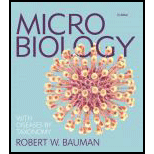
Microbiology with Diseases by Taxonomy (5th Edition)
5th Edition
ISBN: 9780134019192
Author: Robert W. Bauman Ph.D.
Publisher: PEARSON
expand_more
expand_more
format_list_bulleted
Concept explainers
Question
Chapter 14, Problem 7FIB
Summary Introduction
Introduction:
Microorganisms that cause disease are termed as pathogens or the infectious causative agents. When a pathogen invades the tissue of an individual it will lead to infections.
Expert Solution & Answer
Want to see the full answer?
Check out a sample textbook solution
Students have asked these similar questions
What is the structure and function of Eukaryotic cells, including their organelles? How are Eukaryotic cells different than Prokaryotic cells, in terms of evolution which form of the cell might have came first? How do Eukaryotic cells become malignant (cancerous)?
What are the roles of DNA and proteins inside of the cell? What are the building blocks or molecular components of the DNA and proteins? How are proteins produced within the cell? What connection is there between DNA, proteins, and the cell cycle? What is the relationship between DNA, proteins, and Cancer?
Why cells go through various types of cell division and how eukaryotic cells control cell growth through the cell cycle control system?
Chapter 14 Solutions
Microbiology with Diseases by Taxonomy (5th Edition)
Ch. 14 - In which type of symbiosis do both members benefit...Ch. 14 - Prob. 2MCCh. 14 - Prob. 3MCCh. 14 - The most frequent portal of entry for pathogens is...Ch. 14 - Prob. 5MCCh. 14 - Prob. 6MCCh. 14 - Which of the following are most likely to cause...Ch. 14 - Prob. 8MCCh. 14 - When pathogenic bacterial cells lose the ability...Ch. 14 - Prob. 10MC
Ch. 14 - Which of the following statements is the best...Ch. 14 - Which of the following types of epidemiologists is...Ch. 14 - Prob. 13MCCh. 14 - Prob. 14MCCh. 14 - Prob. 15MCCh. 14 - Prob. 1FIBCh. 14 - Prob. 2FIBCh. 14 - Prob. 3FIBCh. 14 - Prob. 4FIBCh. 14 - Diseases that are naturally spread from their...Ch. 14 - Prob. 6FIBCh. 14 - Prob. 7FIBCh. 14 - The total number of cases of a disease in a given...Ch. 14 - Prob. 9FIBCh. 14 - Prob. 10FIBCh. 14 - Prob. 1VICh. 14 - Prob. 2VICh. 14 - List four types of symbiotic relationships, and...Ch. 14 - Prob. 2SACh. 14 - Prob. 3SACh. 14 - Prob. 4SACh. 14 - Prob. 5SACh. 14 - Prob. 6SACh. 14 - Describe the parenteral route of infection.Ch. 14 - In general, contrast transient microbiota with...Ch. 14 - Contrast the terms infection and morbidity.Ch. 14 - Prob. 10SACh. 14 - Explain why Ellen H., a menopausal woman, may have...Ch. 14 - Prob. 2CTCh. 14 - A 27-year-old woman went to her doctors office...Ch. 14 - Over 30 children younger than three years of age...Ch. 14 - Prob. 7CTCh. 14 - Using the data in the Clinical Case Study:...Ch. 14 - Corals are colonial marine animals that feed by...Ch. 14 - Prob. 10CTCh. 14 - Using the following terms, fill in the following...Ch. 14 - Prob. 1TMWCh. 14 - Prob. 2TMWCh. 14 - Prob. 3TMWCh. 14 - Why is mutated Streptococcus pneumoniae, which...Ch. 14 - Prob. 5TMWCh. 14 - Why cant we correctly say that all arthropod...Ch. 14 - Why is an acute disease with a high rate of...Ch. 14 - Prob. 8TMWCh. 14 - Prob. 1CCSCh. 14 - In the early fall, a neonatal nurse n a large...Ch. 14 - Clinical Case Study Legionella in the Produce...Ch. 14 - Prob. 1EDCS
Knowledge Booster
Learn more about
Need a deep-dive on the concept behind this application? Look no further. Learn more about this topic, biology and related others by exploring similar questions and additional content below.Similar questions
- In one paragraph show how atoms and they're structure are related to the structure of dna and proteins. Talk about what atoms are. what they're made of, why chemical bonding is important to DNA?arrow_forwardWhat are the structure and properties of atoms and chemical bonds (especially how they relate to DNA and proteins).arrow_forwardThe Sentinel Cell: Nature’s Answer to Cancer?arrow_forward
- Molecular Biology Question You are working to characterize a novel protein in mice. Analysis shows that high levels of the primary transcript that codes for this protein are found in tissue from the brain, muscle, liver, and pancreas. However, an antibody that recognizes the C-terminal portion of the protein indicates that the protein is present in brain, muscle, and liver, but not in the pancreas. What is the most likely explanation for this result?arrow_forwardMolecular Biology Explain/discuss how “slow stop” and “quick/fast stop” mutants wereused to identify different protein involved in DNA replication in E. coli.arrow_forwardMolecular Biology Question A gene that codes for a protein was removed from a eukaryotic cell and inserted into a prokaryotic cell. Although the gene was successfully transcribed and translated, it produced a different protein than it produced in the eukaryotic cell. What is the most likely explanation?arrow_forward
- Molecular Biology LIST three characteristics of origins of replicationarrow_forwardMolecular Biology Question Please help. Thank you For E coli DNA polymerase III, give the structure and function of the b-clamp sub-complex. Describe how the structure of this sub-complex is important for it’s function.arrow_forwardMolecular Biology LIST three characteristics of DNA Polymerasesarrow_forward
arrow_back_ios
SEE MORE QUESTIONS
arrow_forward_ios
Recommended textbooks for you
 Medical Terminology for Health Professions, Spira...Health & NutritionISBN:9781305634350Author:Ann Ehrlich, Carol L. Schroeder, Laura Ehrlich, Katrina A. SchroederPublisher:Cengage LearningEssentials of Pharmacology for Health ProfessionsNursingISBN:9781305441620Author:WOODROWPublisher:Cengage
Medical Terminology for Health Professions, Spira...Health & NutritionISBN:9781305634350Author:Ann Ehrlich, Carol L. Schroeder, Laura Ehrlich, Katrina A. SchroederPublisher:Cengage LearningEssentials of Pharmacology for Health ProfessionsNursingISBN:9781305441620Author:WOODROWPublisher:Cengage- Case Studies In Health Information ManagementBiologyISBN:9781337676908Author:SCHNERINGPublisher:Cengage

Medical Terminology for Health Professions, Spira...
Health & Nutrition
ISBN:9781305634350
Author:Ann Ehrlich, Carol L. Schroeder, Laura Ehrlich, Katrina A. Schroeder
Publisher:Cengage Learning

Essentials of Pharmacology for Health Professions
Nursing
ISBN:9781305441620
Author:WOODROW
Publisher:Cengage


Case Studies In Health Information Management
Biology
ISBN:9781337676908
Author:SCHNERING
Publisher:Cengage


Bacterial Endospore Formation -Biology Pundit; Author: Biology Pundit;https://www.youtube.com/watch?v=6_sinRhE8zA;License: Standard YouTube License, CC-BY
Taxonomy of Bacteria: Identification and Classification; Author: Professor Dave Explains;https://www.youtube.com/watch?v=8IJRzcPC9wg;License: Standard YouTube License, CC-BY